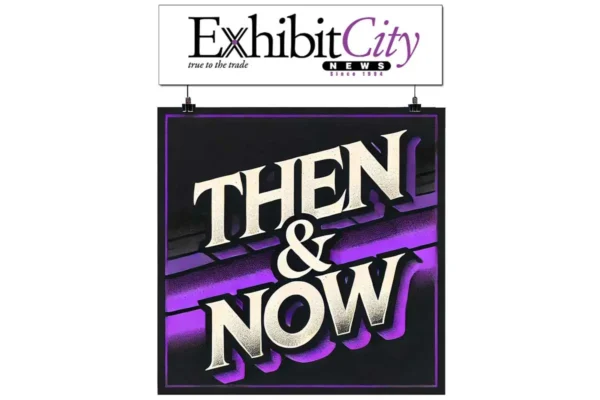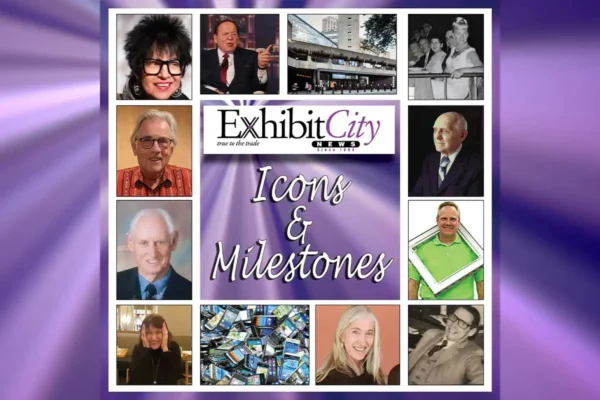The following article is the first article in Exhibit City New’s Show Floor Etiquette Series. Please check back for future installments. For Part 2 Click Here.
Load-in and Load-out Survival Guide
Being the new kid on the block can be challenging, especially when that block is over a million square feet of exhibition space. According to the Center for Exhibition Industry Research (CEIR), more than 14,000 trade shows and conventions are held annually in the United States. Traversing the geography of this event set-up and strike can be intimidating, especially for a newbie. On most days, the exhibit hall concrete jungle is buzzing with activity. The cracking of crates, the slap of carpet on stone, and the constant beeping of scissors lifts create a cacophony that can stun first-timers first timers on the show floor. The hum of thousands of laborers moving in seamless synchronicity can glaze the eyes of a newcomer.
When you are a rookie, you need more than a rock to beat the Goliath of the expo landscape. Even with all the training, everyone experiences awkward, fledgling lessons their first few times on the job. To survive—and thrive—you need the inside scoop from generations of suppliers who have been there and done that.
We spoke to the experts and consolidated their advice into a quick reference overview. We have organized tips into easy-to-follow categories that tackle the various things you may encounter in the early days of your career. With our handy guide and your skills, you might go from mentee to master in no time.
Our Experts:
Alyson Lyden, CEM/Order Defined
With over 20 years in hotel operations, events, and trade shows, Alyson Lyden knows how to connect the dots for her clients. “I bridge the gaps and organize the chaos,” she says.
White glove standards are second nature to Lyden. With a foundation in Project Management from the Waldorf Astoria Hotel in NYC, Lyden integrates personalized and refined service into everything she does. Her background in tradeshows and events incorporates experiences such as being the C-level event manager for AB InBev’s global headquarters, business development manager for Freeman, and project management for agency and custom fabrication partners. Her experiences allowed her to bring that service to her exhibit clients, especially when she started her company in 2023, providing services to her former colleagues and clients. As a proud CEM (Certified in Exhibition Management) and owner of Order Defined, Alyson continues to bring order to the disorganized. She helps her clients navigate the confusing world of the show floor.
Julie Kagy, Exhibition Services and Contractors Association (ESCA)
After graduating from Purdue University Northwest, Julie Kagy launched her career at the Ritz-Carlton Four Seasons Chicago, where she contributed to the hotel’s recognition as a Top North American Hotel by Conde Nast Traveler four times. Transitioning to the tradeshow industry with GES, Kagy spent 12 years honing her skills in various roles, including Exhibitor Services Manager, Director of Account Management, and Vice President of National Account Management.
Kagy joined the Exhibition Services and Contractors Association (ESCA) in 2015 and is currently the Executive Director, a role she wholeheartedly embraces. Passionate about collaborating with industry leaders, she dedicates herself to shaping the future of the trade show industry and fostering innovation. She explains, “We specialize in minimizing the impact when things go wrong.”
ESCA is the premier association for industry leaders in the meetings, exhibitions, and hospitality industry. Kagy tapped her well-seasoned membership for their insider tips and tricks to help the rookies peek behind the velvet curtain.
Pre-Game
To increase your confidence the first few times on the show floor, get ahead of the curve by prepping in advance.
- Heavy Reading: While overwhelming, the Exhibit Kit is your atlas. There’s a reason why they can be hundreds of pages long. It is the script for the entire show. The kit will tell you critical dates, supplier instructions, load-in and out schedules, details of the event, where to store your empties, and more. It is your North Star that will navigate you through the load-in and load-out.
The document is vital for understanding labor jurisdictions. Each city, venue, and show will have specific requirements. Understanding if you are dealing with union or non-union, exclusive electrical, or other mandates can help lay the foundation for a more stress-free experience.
- The advance warehouse can be your best friend: Take advantage of the advance warehouse instead of sending your freight to the show site. It could save you time and money. If you ship your freight directly to the show site, your shipment could be queued with all other shipments and delivered on a first-come, first-serve basis. Your truck may pull into the lot at the beginning of the day, but your freight may only unload hours later, depending on your shipment’s spot in line.
Usually, freight from the advance warehouse has been sorted, tagged, and loaded strategically for smooth floor delivery. Shipments sent to the advance warehouse are usually unloaded and delivered first.
This tip is excellent for any hanging signage as well. Hanging signs can have safety and engineering requirements. They may require additional approvals before being hung. Signage that arrives at the advance warehouse often goes through the approval process in the warehouse and is usually hung before the booth’s set-up.
- Bring a well-stocked toolbox: Being prepared on the job doesn’t just mean the essentials. You never know what can happen when you are on the show floor. If something pops up, the nearest store could be miles away. To prepare for the unexpected, pre-stock your toolbox with more than you need. Include tape, bandages, essential tools, zip ties, scissors, wire cutters, and more.
- Budget for your labor, not your bottom line: When planning for labor, estimate realistic hours rather than what you hope your hours will be. Billing occurs on actuals, not estimates. Not only will realistic planning help you not be surprised when you get your invoice, but it will also allow the official service provider to plan for the skilled labor of the entire event more accurately.
Sustainability and Collaboration:
Part of walking the path like a pro is to think about your footprint.
- Reduce, reuse, recycle, repurpose, and repair: Sustainability is more than a buzzword. As convention centers, venues, exhibitions, and events focus on green initiatives, the need to become more sustainable has grown. Minimize waste, use eco-friendly packing, and practice the five R’s of sustainability wherever possible.
Booth Set-up and Logistics:
Logistics are the backbone of events. Understanding the process and adequately planning for it will help you build the proverbial muscle of a seasoned supplier.
- There is a method to the madness: The show floor and your booth unfold in strategic layers. Everything has a reason and rhyme given the sophisticated operation necessary to produce these well-oiled events. While there are always exceptions to the rules, generally, a show unfolds in order. The show floor is marked, and booth spaces are defined. Signs are hung. Electrical is placed. The carpet is laid. Structures are built. Then, furniture is placed. Like a game of Tetris, each piece follows a particular order for it to snap into place. You will understand the flow as you become more familiar with the operation.
- Lay it out: Prepare and submit actionable booth diagrams and production schedules. Know the placement of everything in your booth (including power). Plan to efficiently use the space within your booth area to maximize visibility and accessibility. Create a production schedule with pertinent details for your partners, including move-in and move-out schedules. Maintain clear communication with all parties to help aid in a smooth process.
- Certifiable: All organizations working on the show floor must submit a certificate of insurance (COI). Your exhibit kit will identify your minimum insurance requirements for that show.
- Bring something to do: Even in the fast-paced world of load-in and load-out, there will be downtime, especially as things are systematically unfolding. Load-in and load-out days are great for working on your laptop, catching up on emails, or sorting through the ancillary last-minute details. Load-out days can take longer, especially for larger shows, as empty crates only arrive once the floor carpet is pulled. Plan team dinners, grab a cocktail, or hire labor to pack your booth on final days.
Shipping:
Your freight is your foundation. Simple steps to ensure smooth delivery and return may help you avoid unnecessary stress.
- Get weighed: When shipping your freight, have your carrier weigh it on a certified scale before shipping and include both light and heavy-weight tickets. Without the tickets, you may have to get weighed in the marshaling yard, which could delay your shipment’s arrival at your booth. Contact the General Services Provider (GSP) to confirm the marshaling yard requirements for certified weight tickets. Each show is different. You may have a smoother experience if you take this step.
- Double-check your BOL: On the show’s last day, you are responsible for turning in your Bill of Lading (BOL) to exhibitor services so they know what will happen with your freight at the show’s end. Ensure you have your outgoing BOL prepared and with your shipment. Double-check the carrier’s name and destination details noted. Minor, silly errors in this process can cause your shipments not to be routed correctly, which may cause delays and added costs. If your BOL does not match your carrier’s information when the carriers show up, the General Service Provider (GSP) may have to reroute it to their warehouse. You may incur additional costs for transferring and storing your items while rectifying the miscommunication.
Safety and Compliance:
Maintaining a safe and compliant environment on the show floor is critical, especially with hundreds of moving parts happening simultaneously. Not cutting corners and erring on the side of caution are characteristics of a professional.
- Keep it clear: Your space can quickly become overwhelmed when unpacking and packing booth items. As the detritus stacks up, try to keep it out of the aisles. Items strewn outside your booth lines can block forklifts or cause tripping hazards.
- Do not be a blockhead: Avoid blocking emergency exits, fire extinguishers, and other life-saving devices with crates or tools. Every second counts in an emergency, so be mindful that your items do not block vital emergency access points.
- Just because it’s there doesn’t mean you should stand on it. Your mother was right when she told you not to climb on the furniture. Although using the side table for a quick-fix boost can be tempting when you’ve already folded the ladder, the risk is not worth the reward. Never use furniture or fixtures for unintended purposes. Little mistakes like this can often cause unnecessary injuries.
- Keep it freight-free: Certain aisles are marked “No Freight.” These aisles are needed for moving around the show floor, allowing forklift access, and in case of emergencies. Respect designated aisles marked as “No Freight” and ensure they remain clear.
Final Pieces of Advice:
Some lessons you learn through experience. These last takeaways come from those who have seen and done it all.
- Use your voice: When you’re a newbie, you might have major imposter syndrome. Because everything feels new, it’s hard to differentiate between the severity of situations. It’s easy to intimidate yourself into silence. If something feels wrong, feel free to ask. Not only will you learn something, but you may also help prevent costly or dangerous errors.
- Be flexible and prepared to adapt: Every pro will tell you that Murphy knew his law. Even with the best-laid plans, things can go wrong. That is the nature of setting up high-stress, intensely detailed live events. When something unexpected occurs, stay focused on finding a workable solution. While different than what you envisioned, several alternate remedies may be available.
- We are all in it together: Even though you work inside booth lines, remember that collaboration has no borders. If you see your neighbor struggling, lend a hand where you can.
- You are on a stage: Remember that you always represent your company, even behind the scenes. How you behave on the floor is observed by more than just the crew you are with.
Be mindful of your noise levels, language, and behavior during set-up and teardown. Maintain a professional and respectful environment. Do your best to create a positive environment for yourself and those around you. When you are on the show floor, you are an ambassador for the show, the city, and the industry. Everyone is working toward the common goal of a successful show. Be mindful and proud that you are a part of something bigger.
You help fuel a multi-billion-dollar industry. Arming yourself with a few of these inside tricks will give you the confidence to take your place next to the pros.
Do you have a few additional tips to add to the list? Join the conversation by sending them here!
This story originally appeared in the Q2 2024 issue of Exhibit City News, p. 60. For original layout or to read the full story, visit https://issuu.com/exhibitcitynews/docs/ecn_q1_2024.






























